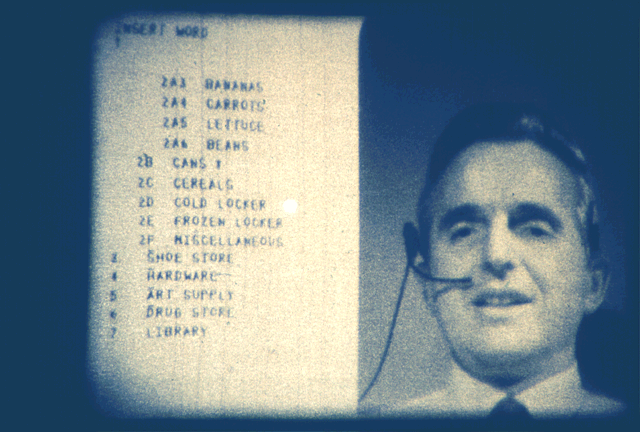Je ne sais pas ce que la sillicon valley fera lorsqu’elle aura épuisé les idées de Doug. Alan Key
 “My name is Douglas Engelbart” C’est ainsi que Douglas Engelbart commence son intervention le 9 décembre 1968a à la Fall Joint Computer Conference. L’amphithéatre est comble. Le public est composé de jeunes ingénieurs qui il y a une poignées d’années souhaitaient voir aux pieds de leurs sapins de Noël des kits d’électronique. Engelbart est debout, il porte une oreillette et tient un micro. Derrière lui un immense écran. Il s’ assied à une table sur laquelle on peut reconnaître un clavier relié à deux objets inconnus. A gauche, une petite boite avec 5 espèces de touches de piano. A droite une boite en bois avec trois boutons qui jaillissent comme des antennes de homard.
“My name is Douglas Engelbart” C’est ainsi que Douglas Engelbart commence son intervention le 9 décembre 1968a à la Fall Joint Computer Conference. L’amphithéatre est comble. Le public est composé de jeunes ingénieurs qui il y a une poignées d’années souhaitaient voir aux pieds de leurs sapins de Noël des kits d’électronique. Engelbart est debout, il porte une oreillette et tient un micro. Derrière lui un immense écran. Il s’ assied à une table sur laquelle on peut reconnaître un clavier relié à deux objets inconnus. A gauche, une petite boite avec 5 espèces de touches de piano. A droite une boite en bois avec trois boutons qui jaillissent comme des antennes de homard.
Douglas Engelbart est ingénieur de formation. Depuis des années, il tente de faire part de sa “vision” d’une “interface homme-machine” qui augmenterait ses capacités cognitives. Engelbart est un homme pour le moins curieux et ses idées sont violemment rejetées. Mais en 1952, les militaires ont besoin d’hommes curieux aux idées curieuses. Il obtient un poste et un financement au SRI de Stanford ce qui lui permet de Au SRI, il met en place des expériences de dynamique de groupe couplées a la technologie : dans l’une d’elle, les participants d’une conférence disposent de boitiers de vote et le conférencier s’arrête si le taux de satisfaction tombe en-deçà de 50%
L’intervention sera appelée Mother of All the Demos par Steven Levy pour avoir fait la démonstration de la souris, de l’interface visuelle (GUI, Graphical User Interface), du multi-fenêtrage, du réseau, de l’édition en ligne, de la recherche d’information au travers du réseau, de la vidéo conférence, du dictionnaire en ligne, de l’hypertexte et de l’hypermédia, du contrôle de la version des documents, du formattage des textes, de l’architecture client-serveur.
Lorsque Engelbart prend la parole, les ordinateurs sont encore des machines qui occupent des pièces entières. La carte perforée est encore l’interface avec laquelle les opérateurs communiquent avec les machines. L’idée de pouvoir avoir un ordinateur à soi, qu’il devienne un objet intime, est révolutionnaire tout comme celle qui fait de l’écran l’interface de communication
Voici le la transcription de l’introduction de cette fameuse démo :
My name is Douglas Engelbart and the research project I am going to describe has been going on down the road at the Standford Research Institute. While I am the only person you’ll seen up here today, I am actually backed up with a staff working not just back stage, but also in Menlo Park, where all the computing you’ll see is actually occuring. I’d like you to fantasize wiht me the moment, to come ans share the experience I’m going to describe for you. If in your office, you where supplied with a computer display that was alive for you all day, that was responsive to you without having to wait in turn, intimately responsive to you and only you, how much value could you derive from that ?
This basically describe what we’ve been pursuing for many years; we call it the Augmented Human Intellect Research Project at SRI. We’ve trying to augment man’sintellect with the machine, whith the computrer. We’re going to show you, rather that tell you about it.Hopefully, it will all work, but bear with me if you havec a few rought spots… In my office i have a terminal like this. There are 12 of theses in our operation. What we’re really working on is the ‘man-computer interface’ – how you coul arrange an manipulate information if you had a computer you could call your own and the kind of tools you might need to do so…
We have been working on redefining the ways that you migh work with information. For instance,here’s a very important file for me: it’s my shopping list, created by my wife. That’s Bill English, one of the key guy helping me put this together. This is obviously a live television image, but we imagine that you [will be able] to havec a number of different view of you data, or even completely different data form different operation you were performing and each could be in its own space. We call them windows. Now that we’ve taken you through all theses stages, we can finally demonstrate what the project is all about. Our efforts havec been focuses on aungmenting man’s intellect, making us better able to work on problems, and to better work together. So what we’ve created is a way that we can work collectively, form different terminals on the same problem. Douglas Engelbart

Et le bonhomme a toujours bon pied bon oeil !
Ce type est le Leonard de Vinci des mondes numériques !